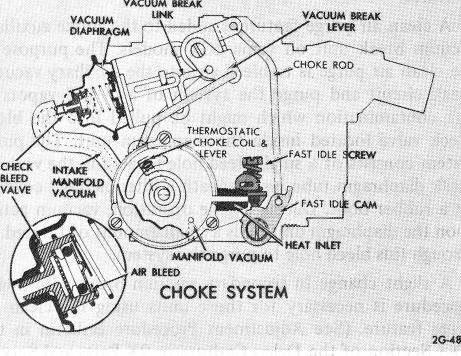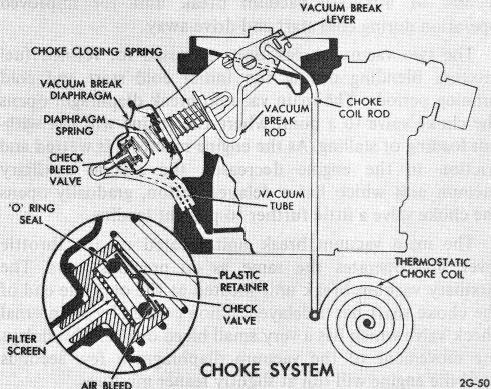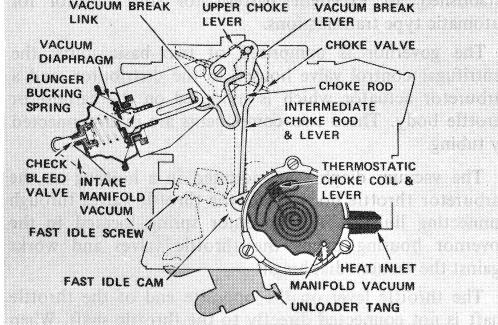| |
|
|
|
|
|
|
|
|
|
|
|
|
|
|
9D-3
|
| |
|
|
|
|
|
|
|
|
|
|
|
|
MODELS 2G-2GC-2GV PAGE 15
|
| |
|
|
|
|
|
|
|
|
|
|
|
|
|
|
|
|
DELAYED VACUUM BREAK SYSTEM (2GC AND 2GV) (Fig. 22)
|
|
|
|
|
In addition to the delayed vacuum break unit which retards choke valve opening just after initial cold engine starting, a tension spring has been added to the choke vacuum break diaphragm plunger on certain 2GC and 2GV models (Figure 23).
|
| |
|
|
|
|
|
|
|
|
| |
 |
|
|
|
| |
|
|
|
The purpose of the tension (bucking) spring is to offset tension of the thermostatic coil. With the addition of the bucking spring in the vacuum break diaphragm plunger, the choke valve can be modulated through the thermostatic coil so that leaner mixtures are maintained during warmer temperatures and richer mixtures for colder temperature operation. This is accomplished in the following manner:
|
| |
|
|
|
During extreme cold operation, the thermostatic coil has considerably more pressure than during warmer temperatures; consequently, the thermostatic coil operating against the bucking spring on the vacuum diaphragm plunger compresses the plunger spring further and thus the choke valve does not open as far, allowing richer mixtures for the colder temperature. Conversely, during warmer temperatures, the thermostatic coil has less tension during the starting period so that the plunger "bucking" spring is not compressed as much and consequently, the vacuum break diaphragm plunger opens the choke valve further supplying a leaner mixture for the warm-up period. In this manner, choke valve opening through the vacuum break diaphragm can be varied to give the correct fuel mixtures, dependent upon outside temperature.
|
| |
|
FIGURE 22
|
|
|
|
|
|
remain in the vacuum break position until the engine begins to warm up and the exhaust heat from the choke stove begins to relax the tension of the choke coil. This allows the choke valve to open gradually through air flow against the offset choke valve, until the engine is warm and the choke valve is fully open.
|
|
The internal check valve in the choke diaphragm unit is designed to "pop" off its seat and allow the diaphragm plunger to extend outward when spring force against the vacuum break diaphragm is greater than the vacuum pull. This gives added enrichment quickly as needed on heavy acceleration during cold drive-away.
|
|
| |
CHOKE CLOSING ASSIST SPRING (Fig. 24)
|
|
|
| |
|
|
|
|
|
|
|
|
| |
 |
|
Some 2GV models use a fixed calibrated restriction in the vacuum channel to the vacuum break diaphragm, in place of an internal check valve, whose purpose is to control vacuum applied to the vacuum break diaphragm plunger to cause it to move slowly inward retarding choke valve opening during cold start.
|
|
|
CHOKE SYSTEM (Fiq. 23)
|
|
|
|
|
|
|
|
| |
|
|
|
|
|
|
|
|
|
 |
|
|
|
| |
|
|
|
|
|
|
|
|
|
| |
|
|
|
|
FIGURE 24
|
|
|
|
| |
|
|
|
|
|
|
|
|
|
| |
|
A choke closing assist spring has been added to the vacuum break diaphragm plunger stein on some 2GV carburetors. The spring assists in closing the choke valve, along with tension from the remote choke thermostatic coil for improved cold starting.
|
| |
|
The choke closing assist spring only exerts pressure on the vacuum break link to assist in closing the choke valve during engine starting.
|
| |
|
|
|
|
|
|
|
|
| |
|
FIGURE 23
|
|
|
|
|
|